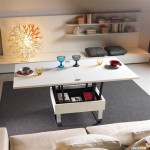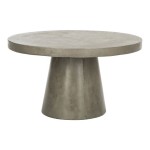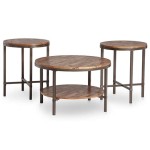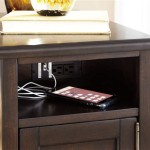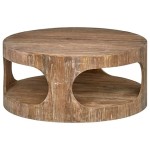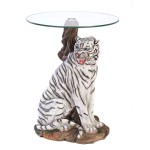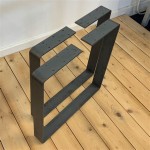What Causes A Glass Patio Table To Shatter On Its Own
Glass patio tables offer a stylish and functional addition to outdoor living spaces. Their smooth surfaces are easy to clean and provide an elegant platform for dining, entertaining, or simply relaxing. However, the seemingly durable nature of these tables can be deceiving. A disconcerting phenomenon that occasionally occurs is the spontaneous shattering of the glass tabletop. This can happen without any apparent external force, leaving homeowners perplexed and concerned. Understanding the underlying causes of this seemingly random event is essential for preventing future incidents and ensuring the safety of those using the patio area.
While it may appear as though the glass shatters inexplicably, a combination of factors typically contributes to this occurrence. These factors involve inherent material properties of glass, manufacturing processes, environmental conditions, and even subtle stresses introduced during installation and use. By examining these potential causes, it becomes possible to assess the risks associated with glass patio tables and take preventative measures to minimize the likelihood of spontaneous breakage.
Inherent Material Imperfections and Manufacturing Processes
One primary reason for the spontaneous shattering of glass patio tables lies within the material itself and how it is processed. Glass, despite its seemingly uniform appearance, is susceptible to microscopic flaws and imperfections that can significantly weaken its structural integrity. These imperfections can arise during the manufacturing process.
The tempering process, widely used to strengthen glass tabletops, involves heating the glass to a high temperature followed by rapid cooling. This creates a compression layer on the surface of the glass, making it more resistant to impact. However, if the cooling process is uneven or if there are pre-existing flaws within the glass, the tempering process can actually exacerbate these weaknesses. Microscopic inclusions, such particles of nickel sulfide (NiS), can become trapped within the glass during manufacturing. These inclusions can undergo a phase change over time, expanding and creating internal stress that eventually leads to fracture.
Nickel sulfide inclusions are a common culprit in spontaneous glass breakage. While manufacturers take precautions to minimize NiS contamination, it is virtually impossible to eliminate it entirely. These inclusions are more likely to cause problems in thicker glass, as used in patio tables, because the larger volume of glass increases the probability of an inclusion being present. Over time, changes in temperature can cause the NiS particle to expand and contract, putting stress on the surrounding glass matrix. Eventually, this stress can exceed the glass's tensile strength, leading to catastrophic failure.
Furthermore, even without NiS inclusions, small surface scratches or chips introduced during handling or installation can act as stress concentrators. These seemingly insignificant imperfections can weaken the glass, making it more vulnerable to breakage under stress. The edges of glass are particularly susceptible to chipping, and if these chips are not properly addressed, they can initiate cracks that propagate through the entire tabletop.
The quality control measures implemented during the manufacturing process play a crucial role in mitigating the risk of spontaneous breakage. Rigorous inspection for surface flaws, proper temperature control during tempering, and measures to minimize contamination are all essential. However, even with the best quality control, it is impossible to guarantee that every piece of tempered glass will be completely free of imperfections and potential weaknesses.
Environmental Factors and Thermal Stress
Environmental factors play a significant role in the overall stress experienced by a glass patio table. Temperature fluctuations, in particular, can induce significant thermal stress within the glass, contributing to its eventual failure. The expansion and contraction of glass due to temperature changes, coupled with any pre-existing flaws or stress concentrations, can significantly weaken the material.
During periods of intense sunlight, the glass can heat up considerably, causing it to expand. Conversely, during cooler evenings or overnight, the glass contracts. This repeated cycle of expansion and contraction creates stress within the glass, particularly around the edges or any areas with imperfections. Dark-colored glass tabletops absorb more heat than lighter-colored ones, making them more susceptible to thermal stress. The differential heating between the center and the edges of the table also contributes to the stress.
Sudden temperature changes, such as a rapid cooling after a hot day or the application of cold water to a hot glass surface, can be especially detrimental. This thermal shock can create severe stress gradients within the glass, leading to immediate cracking and shattering. Protective measures, such as the use of patio umbrellas to shade the table from direct sunlight, can help minimize these temperature fluctuations and reduce the risk of breakage.
Humidity can indirectly contribute to the problem as well. High humidity levels can exacerbate the effects of temperature changes, causing the glass to expand and contract more significantly. Moreover, moisture can seep into existing cracks or imperfections, further weakening the glass structure. In coastal regions, salt spray can also corrode the glass surface, accelerating the deterioration process.
Exposure to extreme weather conditions, such as hailstorms or strong winds, can also compromise the integrity of the glass. Hailstones can cause direct impact damage, creating surface chips or cracks that act as stress concentrators. Strong winds can exert pressure on the tabletop, particularly if it is not securely fastened to the table frame, causing it to flex and strain. Over time, this repeated flexing can weaken the glass and increase the risk of shattering.
Structural Support and Installation Issues
The way a glass patio table is supported and installed is also crucial to its long-term durability. An inadequately designed or incorrectly installed table frame can place undue stress on the glass tabletop, leading to premature failure. The frame should provide even support across the entire surface of the glass to distribute the load evenly and prevent localized stress concentrations.
If the table frame is warped or uneven, it can create pressure points on the glass, making it more susceptible to cracking. The use of rubber or plastic spacers between the glass and the frame can help to cushion the glass and prevent direct contact with the metal, reducing the risk of scratching and chipping. These spacers also help to absorb vibrations and minor impacts that could otherwise stress the glass.
The method of attaching the glass to the frame is also important. Screws or clamps that are too tight can create localized stress concentrations, while those that are too loose can allow the glass to shift and flex, leading to fatigue. The fasteners should be tightened to the appropriate torque to provide a secure fit without over-stressing the glass. It's also important to ensure the fasteners are compatible with the glass type to prevent chemical interactions that could weaken the glass.
Furthermore, the surface on which the table is placed can also affect its stability. An uneven patio surface can cause the table to rock or wobble, placing stress on the glass. Shimming the table legs can help to level the table and ensure that the weight is distributed evenly. Placing the table on a soft surface, such as a rug or mat, can also help to absorb vibrations and reduce the risk of breakage.
Even seemingly minor actions, such as placing heavy objects on the edge of the table or repeatedly bumping into it, can contribute to the gradual weakening of the glass. Over time, these small stresses can accumulate and eventually lead to catastrophic failure. Regular inspection of the table for signs of damage, such as cracks or chips, is essential for identifying potential problems before they escalate.
In conclusion, the spontaneous shattering of a glass patio table is rarely a random event. It is usually the result of a combination of factors, including inherent material imperfections, environmental stresses, and structural support issues. Understanding these factors is crucial for preventing such incidents and ensuring the safety and longevity of glass patio furniture. Proper manufacturing processes, careful installation, and regular maintenance are all essential for minimizing the risk of spontaneous glass breakage.

Shattered Glass Table Top Outdoor Replacement

Glass Tables Are Exploding Here S Why

Glass Tables Are Exploding Here S Why

Glass Tables Are Exploding Here S Why

Glass Tables Are Exploding Here S Why

What Causes Glass To Shatter By Itself

Causes Of Spontaneous Glass Breakage And How To Prevent It Sieger Architektur Systems

What Causes Glass To Shatter By Itself

Why We Re Not Worried About Pyrex Bakeware Exploding Wirecutter

Shattered Glass Table Top Outdoor Replacement
Related Posts


